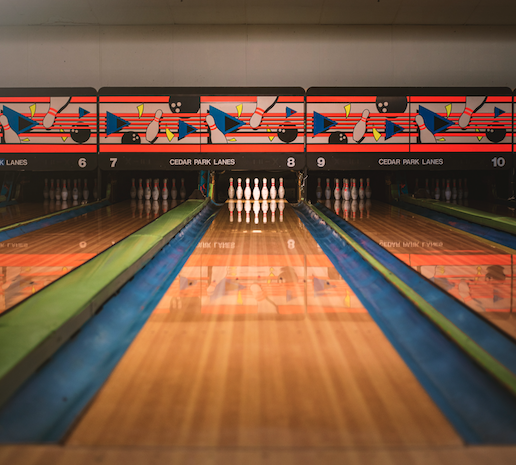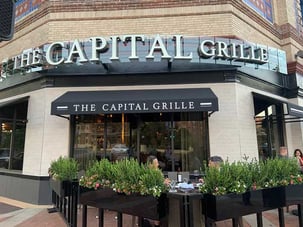
DESIGNING A FAMILY FUN CENTER
All across the country, family fun centers serve as go-to spots for birthday parties, class field trips, first dates and more. These unique entertainment venues cater to young children, teenagers, young adults and parents alike. Because these venues need to entertain such a wide group of customers, they present a unique challenge for developers and operators looking to create a seamless experience throughout the entire facility.
Which attractions are the best?
Nothing says “family fun center” like variety. Today’s best family entertainment centers feature multiple attractions. Each of these attractions come with its own electrical, plumbing and ventilation challenges. Here are some of the most popular attractions for today’s leading family fun centers.
- Bowling Alley: This timeless classic attraction within family fun centers brings families and friends together regardless of their age or skill level. Bowling alley attractions typically consist of four to eight lanes with automatic ball and pin systems, a shoe rental desk and multiple options for weighted bowling balls. Lighting and power coordination for these spaces is critical to the end user experience.
- Laser Tag: An interactive action-packed experience, laser tag arenas combine strategy and teamwork between adults and players as young as six years old. Laser tag is a popular attraction as an automatic team-building activity that is easy to learn and fun to play. These spaces are typically indoors, and the conditioning/temperature control are crucial to ensure patrons’ uninterrupted enjoyment.
- Arcade Centers: Arcade centers are filled with interactive and eye-catching games that are entertaining for all ages. They range from the latest, most advanced VR video games to nostalgia-inducing games like air hockey, pinball and Skee-Ball. To accommodate a wide range of games and activities that can make up the arcade, it is essential to have adequate power. Because the cost of utility installations and alterations is a substantial cost, ensuring these are sized properly for the operator’s use is paramount.
- Mini Golf: Mini golf is a classic family fun center attraction for people of all ages. Mini golf courses are typically designed with a consistent theme like "Jurassic Park" or "Pirate Island." Historically, these attractions covered a large footprint and were built outdoors; however, mini golf attractions are becoming more popular as indoor venues to be less dependent on good weather for customers’ enjoyment. With so much innovation happening in this space, more operators are leveraging technology to maximize their visitors’ mini golf experience while reducing the amount of space required within a venue. The latest mini golf developments require careful consideration of power requirements and proper lighting to ensure customers get the most out of their mini golf experience.
- Food and Beverage: To keep customers engaged (and fueled) throughout their visit, family fun centers need to have food and beverage options. Although the focus is often on the attractions, food and beverage options can be a deciding factor for a guest’s decision to visit a particular venue. Likewise, a terrible dining experience can be a deterrent for customers. If you’ve ever visited a restaurant and have left smelling and feeling like you’re covered in grease, you know how important proper kitchen ventilation is to the end-user experience.
Finding the right partners
Like any commercial real estate development, family fun centers are complex. It takes an efficient, highly communicative team of professionals from multiple industries to create the finished product. At Dialectic Engineering, we are proud to partner with developers, construction managers, architects and any other organization involved in a project. We are also licensed in all 50 U.S. states and have developed a proprietary catalogue of federal, state and local regulations around the country, making us the perfect MEP engineering partner for any project regardless of size or location.
Designing and developing your kitchen
Family fun center kitchens offer food options ranging from wood-fired pizza to fried chicken tenders and self-serve salad bars. Because of the wide variety of food options needed to serve guests of all ages, family fun center developers need to create a kitchen and dining room designed for efficiency, that meets or exceeds applicable codes and regulations. Before you plan out your professional kitchen, here are a few MEP engineering design elements you need to consider.
Ventilation and Exhaust
One of the most important considerations when designing a commercial kitchen is creating ventilation and exhaust systems to remove heat, moisture and hazards such as grease, smoke and steam. A properly designed and installed exhaust system will provide a safe and comfortable working environment for staff and prevent the accumulation of harmful pollutants in the kitchen and dining areas.
Electrical and Plumbing
Kitchens must be equipped with adequate electrical and plumbing systems to operate efficiently. Commercial kitchen equipment typically requires significant electrical power and dedicated circuits to operate, and the plumbing systems must be designed to accommodate the high volume of water usage associated with cooking, dishwashing and sanitation.
Energy Efficiency
It is critical to consider the overall energy efficiency of the MEP systems in the kitchen. Investing in energy-efficient appliances, lighting and HVAC systems can result in significant cost savings over time and reduce the environmental impact of the family fun center's operations.
At Dialectic, we’re experts at delivering innovative, inspiring commercial kitchen designs. From five-star restaurants to high-efficiency, fast-casual concepts, we partner with our clients to create the perfect kitchen and dining room experience.
Considerations before building an indoor bowling alley
When building an indoor bowling alley for a family fun center, there are several key MEP engineering challenges that developers must keep in mind for a successful project.
Air Flow and Ventilation
Entertainment venues typically consist of large, open spaces. Areas like these are often difficult to heat, cool and provide adequate airflow throughout. The space must be adequately ventilated to ensure that fresh air flows continuously throughout all corners of the room and carbon dioxide levels are kept at a minimum. MEP engineers ensure this by designing custom ventilation systems for bowling alley spaces.
Electricity
It takes a lot of power to run a family fun center. Arcade games, attractions and specialized bowling equipment like pin setting machines, bowling ball return systems and personal scoreboards need to be calculated and designed carefully to ensure that power distribution systems and electrical panels can withstand the high load demands without causing any interruptions or failures.
Lighting Design
Bowling lanes have a thin layer of oil on top of the wood. This oil layer can cause glare or light shadowing that may impact the players. Because of this, bowling alleys need custom lighting design solutions to reduce glare and shadowing while illuminating the rest of the space where people can eat, drink and watch the action.
Considerations before building an indoor laser tag attraction
Laser tag arenas, some of the highest intensity attractions at a family entertainment center, bring energy and excitement to everyone that puts the laser pack on. These arenas are unlike any other entertainment venue and require specialized MEP systems to operate properly.
HVAC
Laser tag arenas are often enclosed spaces with people carrying heavy battery packs. Because of all the action, these spaces can quickly heat up. HVAC systems must be designed to provide adequate ventilation and air conditioning to keep the indoor space comfortable and safe for players. Proper insulation must also be included to minimize climate control loss and improve energy efficiency.
Power Supply
Laser tag arenas need a lot of power to operate. From the staging room that may hold up to 50 rechargeable packs for players to use to the unique scenery lighting, sound systems and smoke machines, it is important to have a reliable power source and redundant backup sources in the event of a power loss.
Considerations before building a miniature golf course
Mini golf courses are one of the leading family fun center attractions, bringing in hundreds of customers each day. These large-scale attractions offer unique challenges to run smoothly.
Plumbing
Classic mini golf course designs often include show-stopping water features like running streams and towering water fountains to wow guests. These intricate water features require custom-produced designs from professional MEP engineers to work properly.
Power Supply
What is a mini golf course without iconic moving features like the classic windmill? Mini golf course design requires reliable power across a large area. When the sun goes down, it is also important to have well-lit paths for guests to continue the fun. MEP engineers specialize in designing unique electrical systems that light up paths and power moving features on a family fun center mini golf course.
Family entertainment centers continue to attract customers for their lively atmosphere and must-experience attractions. At Dialectic, we engineer better experiences. From sustainable and efficient kitchens to eye-catching water features, we are here to help real estate developers take their projects to the next level. Contact us today to learn more about how we can help with your MEP engineering needs.

